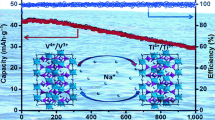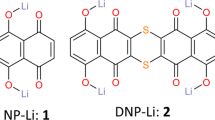Abstract
p-Benzoquinone (BQ) is a promising candidate for next-generation sodium-ion batteries (SIBs) because of its high theoretical specific capacity, good reaction reversibility, and high resource availability. However, practical application of BQ faces many challenges, such as a low discharge plateau (∼2.7 V) as cathode material or a high discharge plateau as anode material compared with inorganic materials for SIBs and high solubility in organic electrolytes, resulting in low power and energy densities. Here, tetrahydroxybenzoquinone tetrasodium salt (Na4C6O6) is synthesized through a simple neutralization reaction at low temperatures. The four −ONa electron-donating groups introduced on the structure of BQ greatly lower the discharge plateau by over 1.4 V from ∼2.70 V to ∼1.26 V, which can change BQ from cathode to anode material for SIBs. At the same time, the addition of four −ONa hydrophilic groups inhibits the dissolution of BQ in the organic electrolyte to a certain extent. As a result, Na4C6O6 as the anode displays a moderate discharge capacity and cycling performance at an average work voltage of ∼1.26 V versus Na/Na+. When evaluated as a Na-ion full cell (NIFC), a Na3V2(PO4)3 ‖ Na4C6O6 NIFC reveals a moderate discharge capacity and an average discharge plateau of ∼1.4 V. This research offers a new molecular structure design strategy for reducing the discharge plateau and simultaneously restraining the dissolution of organic electrode materials.
Similar content being viewed by others
References
J. Yi, P.C. Liang, X.Y. Liu, K. Wu, Y.Y. Liu, Y.G. Wang, Y.Y. Xia, and J.J. Zhang, Challenges, mitigation strategies and perspectives in development of zinc-electrode materials and fabrication for rechargeable zinc-air batteries, Energy Environ. Sci., 11(2018), No. 11, p. 3075.
Y.Q. Tang, X. Liu, X.B. Huang, X. Ding, S.B. Zhou, and Y.D. Chen, Synthesis and electrochemical properties of Li2FeSiO4/C/Ag composite as a cathode material for Li-ion battery, J. Cent. South Univ., 26(2019), No. 6, p. 1443.
Z.M. Zheng, H.H. Wu, H.X. Chen, Y. Cheng, Q.B. Zhang, Q.S. Xie, L.S. Wang, K.L. Zhang, M.S. Wang, D.L. Peng, and X.C. Zeng, Fabrication and understanding of Cu3Si-Si@carbon@graphene nanocomposites as high-performance anodes for lithium-ion batteries, Nanoscale, 10(2018), No. 47, p. 22203.
Q.H. Chen, Y. Cheng, H.D. Liu, Q.B. Zhang, V. Petrova, H.X. Chen, P. Liu, D.L. Peng, M.L. Liu, and M.S. Wang, Hierarchical design of Mn2P nanoparticles embedded in N, P-codoped porous carbon nanosheets enables highly durable lithium storage, ACS Appl. Mater. Interfaces, 12(2020), No. 32, p. 36247.
F. Jin, J. Li, C.J. Hu, H.C. Dong, P. Chen, Y.B. Shen, and L.W. Chen, High performance solid-state battery with integrated cathode and electrolyte, ACTA Phys. Chim. Sin., 35(2019), No. 12, p. 1399.
K. Chayambuka, G. Mulder, D.L. Danilov, and P.H.L. Notten, Sodium-ion battery materials and electrochemical properties reviewed, Adv. Energy Mater., 8(2018), No. 16, art. No. 1800079.
Z.M. Zheng, H.H. Wu, H.D. Liu, Q.B. Zhang, X. He, S.C. Yu, V. Petrova, J. Feng, R. Kostecki, P. Liu, D.L. Peng, M.L. Liu, and M.S. Wang, Achieving fast and durable lithium storage through amorphous FeP nanoparticles encapsulated in ultrathin 3D P-doped porous carbon nanosheets, ACS Nano, 14(2020), No. 8, p. 9545.
X.J. Nie, X.T. Xi, Y. Yang, Q.L. Ning, J.Z. Guo, M.Y. Wang, Z.Y. Gu, and X.L. Wu, Recycled LiMn2O4 from the spent lithium ion batteries as cathode material for sodium ion batteries: Electrochemical properties, structural evolution and electrode kinetics, Electrochim. Acta, 320(2019), art. No. 134626.
Z.Y. Gu, J.Z. Guo, Z.H. Sun, X.X. Zhao, W.H. Li, X. Yang, H.J. Liang, C.D. Zhao, and X.L. Wu, Carbon-coating-increased working voltage and energy density towards an advanced Na3V2(PO4)2F3@C cathode in sodium-ion batteries, Sci. Bull., 65(2020), No. 9, p. 702.
X.H. Rui, W.P. Sun, C. Wu, Y. Yu, and Q.Y. Yan, An advanced sodium-ion battery composed of carbon coated Na3V2(PO4)3 in a porous graphene network, Adv. Mater., 27(2015), No. 42, p. 6670.
Z.G. Liu, Y.Y. Hu, M.T. Dunstan, H. Huo, X.G. Hao, H. Zou, G.M. Zhong, Y. Yang, and C.P. Grey, Local structure and dynamics in the Na ion battery positive electrode material Na3V2(PO4)2F3, Chem. Mater., 26(2014), No. 8, p. 2513.
F.X. Xie, L. Zhang, D.W. Su, M. Jaroniec, and S.Z. Qiao, Na2Ti3O7@N-doped carbon hollow spheres for sodium-ion batteries with excellent rate performance, Adv. Mater., 29(2017), No. 24, art. No. 1700989.
M.Z. Chen, Q.N. Liu, S.W. Wang, E.H. Wang, X.D. Guo, and S.L. Chou, High-abundance and low-cost metal-based cathode materials for sodium-ion batteries: Problems, progress, and key technologies, Adv. Energy Mater., 9(2019), No. 14, art. No. 1803609.
X. Yan, C.Y. Fan, X. Yang, Y.Y. Wang, B.H. Hou, W.L. Pang, and X.L. Wu, A cation/anion-dually active metal-organic complex with 2D lamellar structure as anode material for Li/Na-ion batteries, Mater. Today Energy, 13(2019), p. 302.
X. Yan, H. Ye, X.L. Wu, Y.P. Zheng, F. Wan, M.K. Liu, X.H. Zhang, J.P. Zhang, and Y.G. Guo, Three-dimensional carbon nanotube networks enhanced sodium trimesic: A new anode material for sodium ion batteries and Na-storage mechanism revealed by ex situ studies, J. Mater. Chem. A, 5(2017), No. 32, p. 16622.
Y.W. Wu, R.H. Zeng, J.M. Nan, D. Shu, Y.C. Qiu, and S.L. Chou, Quinone electrode materials for rechargeable lithium/sodium ion batteries, Adv. Energy Mater., 7(2017), No. 24, art. No. 1700278.
Z.P. Song, Y.M. Qian, T. Zhang, M. Otani, and H.S. Zhou, Poly(benzoquinonyl sulfide) as a high-energy organic cathode for rechargeable Li and Na batteries, Adv. Sci., 2(2015), No. 9, art. No. 1500124.
Z.P. Song, Y.M. Qian, X.Z. Liu, T. Zhang, Y.B. Zhu, H.J. Yu, M. Otani, and H.S. Zhou, A quinone-based oligomeric lithium salt for superior Li-organic batteries, Energy Environ. Sci., 7(2014), No. 12, p. 4077.
S. Muench, A. Wild, C. Friebe, B. Häupler, T. Janoschka, and U.S. Schubert, Polymer-based organic batteries, Chem. Rev., 116(2016), No. 16, p. 9438.
M.E. Bhosale, S.D. Chae, J.M. Kim, and J.Y. Choi, Organic small molecules and polymers as an electrode material for rechargeable lithium ion batteries, J. Mater. Chem. A, 6(2018), No. 41, p. 19885.
J.X. Yang, Y.Q. Shi, P.F. Sun, P.X. Xiong, and Y.H. Xu, Optimization of molecular structure and electrode architecture of anthraquinone-containing polymer cathode for high-performance lithium-ion batteries, ACS Appl. Mater. Interfaces, 11(2019), No. 45, p. 42305.
J.E. Kwon, C.S. Hyun, Y.J. Ryu, J. Lee, D.J. Min, M.J. Park, B.K. An, and S.Y. Park, Triptycene-based quinone molecules showing multi-electron redox reactions for large capacity and high energy organic cathode materials in Li-ion batteries, J. Mater. Chem. A, 6(2018), No. 7, p. 3134.
W.W. Huang, Z.Q. Zhu, L.J. Wang, S.W. Wang, H. Li, Z.L. Tao, J.F. Shi, L.H. Guan, and J. Chen, Quasi-solid-state rechargeable lithium-ion batteries with a calix[4]quinone cathode and gel polymer electrolyte, Angew. Chem. Int. Ed., 52(2013), No. 35, p. 9162.
Z.Q. Zhu, M.L. Hong, D.S. Guo, J.F. Shi, Z.L. Tao, and J. Chen, All-solid-state lithium organic battery with composite polymer electrolyte and pillar[5]quinone cathode, J. Am. Chem. Soc., 136(2014), No. 47, p. 16461.
W.W. Huang, X.Q. Zhang, S.B. Zheng, W.J. Zhou, J. Xie, Z.N. Yang, and Q.C. Zhang, Calix[6]quinone as high-performance cathode for lithium-ion battery, Sci. China Mater., 63(2020), No. 3, p. 339.
H.Y. Chen, M. Armand, M. Courty, M. Jiang, C.P. Grey, F. Dolhem, J.M. Tarascon, and P. Poizot, Lithium salt of tetrahydroxybenzoquinone: Toward the development of a sustainable Li-ion battery, J. Am. Chem. Soc., 131(2009), No. 25, p. 8984.
T. Yokoji, Y. Kameyama, S. Sakaida, N. Maruyama, M. Satoh, and H. Matsubara, Steric effects on the cyclability of benzoquinone-type organic cathode active materials for rechargeable batteries, Chem. Lett., 44(2015), No. 12, p. 1726.
M. Yao, H. Senoh, S.I. Yamazaki, Z. Siroma, T. Sakai, and K. Yasuda, High-capacity organic positive-electrode material based on a benzoquinone derivative for use in rechargeable lithium batteries, J. Power Sources, 195(2010), No. 24, p. 8336.
A. Jouhara, N. Dupré, A.C. Gaillot, D. Guyomard, F. Dolhem, and P. Poizot, Raising the redox potential in carboxyphenolate-based positive organic materials via cation substitution, Nat. Commun., 9(2018), art. No. 4401.
A.E. Lakraychi, E. Deunf, K. Fahsi, P. Jimenez, J.P. Bonnet, F. Djedaini-Pilard, M. Bécuwe, P. Poizot, and F. Dolhem, An air-stable lithiated cathode material based on a 1, 4-benzenedisulf-onate backbone for organic Li-ion batteries, J. Mater. Chem. A, 6(2018), No. 39, p. 19182.
T. Yokoji, H. Matsubara, and M. Satoh, Rechargeable organic lithium-ion batteries using electron-deficient benzoquinones as positive-electrode materials with high discharge voltages, J. Mater. Chem. A, 2(2014), No. 45, p. 19347.
Y. Lu, Q. Zhao, L.C. Miao, Z.L. Tao, Z.Q. Niu, and J. Chen, Flexible and free-standing organic/carbon nanotubes hybrid films as cathode for rechargeable lithium-ion batteries, J. Phys. Chem. C, 121(2017), No. 27, p. 14498.
H. Kim, J.E. Kwon, B. Lee, J. Hong, M. Lee, S.Y. Park, and K. Kang, High energy organic cathode for sodium rechargeable batteries, Chem. Mater., 27(2015), No. 21, p. 7258.
J. Lee, H. Kim, and M.J. Park, Long-life, high-rate lithium-organic batteries based on naphthoquinone derivatives, Chem. Mater., 28(2016), No. 7, p. 2408.
J.F. Xiang, C.X. Chang, M. Li, S.M. Wu, L.J. Yuan, and J.T. Sun, A novel coordination polymer as positive electrode material for lithium ion battery, Cryst. Growth Des., 8(2008), No. 1, p. 280.
Z.Q. Zhu, H. Li, J. Liang, Z.L. Tao, and J. Chen, The disodium salt of 2, 5-dihydroxy-1, 4-benzoquinone as anode material for rechargeable sodium ion batteries, Chem. Commun., 51(2015), No. 8, p. 1446.
J.N. Gu, Y. Gu, and S.B. Yang, 3D organic Na4C6O6/graphene architecture for fast sodium storage with ultralong cycle life, Chem. Commun., 53(2017), No. 94, p. 12642.
Z.L. Jian, W.Z. Han, X. Lu, H.X. Yang, Y.S. Hu, J. Zhou, Z.B. Zhou, J.Q. Li, W. Chen, D.F. Chen, and L.Q. Chen, Superior electrochemical performance and storage mechanism of Na3V2(PO4)3 cathode for room-temperature sodium-ion batteries, Adv. Energy Mater., 3(2013), No. 2, p. 156.
K.Y. Zhang, Y. Li, Y.K. Wang, J.Y. Zhao, X.M. Chen, Y.N. Dai, and Y.C. Yao, Enhanced electrochemical properties of iron oxalate with more stable Li+ ions diffusion channels by controlling polymorphic structure, Chem. Eng. J., 384(2020), art. No. 123281.
H.G. Wang, S. Yuan, Z.J. Si, and X.B. Zhang, Multi-ring aromatic carbonyl compounds enabling high capacity and stable performance of sodium-organic batteries, Energy Environ. Sci., 8(2015), No. 11, p. 3160.
R.R. Zhao, Y.L. Cao, X.P. Ai, and H.X. Yang, Reversible Li and Na storage behaviors of perylenetetracarboxylates as organic anodes for Li- and Na-ion batteries, J. Electroanal. Chem., 688(2013), p. 93.
H.F. Fei, Y.P. Liu, C.L. Wei, Y.C. Zhang, J.K. Feng, C.Z. Chen and H.J. Yu, Poly(propylene carbonate)-based polymer electrolyte with an organic cathode for stable all-solid-state sodium batteries, Acta Phys. Chim. Sin, 36(2020), No. 5, p. 18.
H. Wang, P.F. Hu, J. Yang, G.M. Gong, L. Guo, and X.D. Chen, Renewable-juglone-based high-performance sodium-ion batteries, Adv. Mater., 27(2015), No. 14, p. 2348.
C.Y. Guo, K. Zhang, Q. Zhao, L.K. Pei, and J. Chen, High-performance sodium batteries with the 9, 10-anthraquinone/CMK-3 cathode and an ether-based electrolyte, Chem. Commun., 51(2015), No. 50, p. 10244.
Z.H. Xiang, Q.B. Dai, J.F. Chen, and L.M. Dai, Edge functionalization of graphene and two-dimensional covalent organic polymers for energy conversion and storage, Adv. Mater., 28(2016), No. 29, p. 6253.
Acknowledgements
The authors are grateful to the National Natural Science Foundation of China (No. 21875076), the Science and Technology Planning Project of Guangdong Province (No. 2018A05050677), the Undergraduates’ Innovating Experimentation Project of Guangdong Province (No. S202110574025), and the Undergraduates’ Innovating Experimentation Project of China (No. 202010574034) for financial support.
Author information
Authors and Affiliations
Corresponding author
Rights and permissions
About this article
Cite this article
Chen, Fh., Wu, Yw., Zhang, Hh. et al. The modulation of the discharge plateau of benzoquinone for sodium-ion batteries. Int J Miner Metall Mater 28, 1675–1683 (2021). https://doi.org/10.1007/s12613-021-2261-y
Received:
Revised:
Accepted:
Published:
Issue Date:
DOI: https://doi.org/10.1007/s12613-021-2261-y




